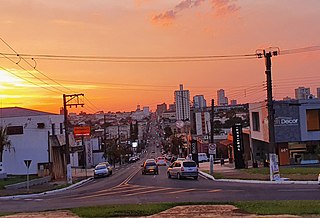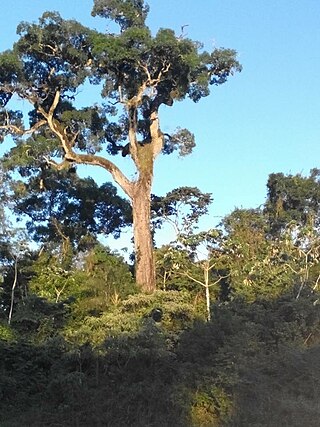
Avaré is a city in the State of São Paulo, Brazil, located 270 km from the state capital, São Paulo. The population is 91,232 in an area of 1213 km2. Established on 15 September 1861 by Major Vitoriano de Souza Rocha and Domiciano Santana, the city was developed around the chapel of Our Lady of the Good Death.

Caraguatatuba, widely known by its abbreviation Caraguá, is a city in the eastern part of the southern state of São Paulo in Brazil. It is part of the Metropolitan Region of Vale do Paraíba e Litoral Norte. The population is 123,389 in an area of 485.10 km². Caraguatatuba is the largest city of São Paulo's north shore. The economy of the Caraguatatuba is driven by agriculture and tourism. The urban area and farmlands are within the coastline and valley areas, the majority of the northern part are heavily forested and rarely serves any roads to that area. The postal boundary dividing the 00000s and the 10000s lies to the southwestern boundary with Salesópolis.

Assis is a city and a municipality in the southwestern part of the state of São Paulo in Brazil. The population is 101,409 in an area of 460.61 km2. The town was founded on July 5, 1905, and became a municipality in 1917, when it was separated from Platina. It is the largest city of its microregion, and the 2nd of its mesoregion, and is 434 km away from the capital, São Paulo. The town has an annual average temperature of 21,37 °C, annual rainfall 1,441 mm (56.7 in), and the vegetation predominates Mata Atlântica and Cerrado, is then a transition zone of vegetation. Its Human Development Index (HDI) is 0.805, considered high if compared to state and is in 28th place among Brazilian cities.

Ibiúna is a municipality in the state of São Paulo in Brazil. It is part of the Metropolitan Region of Sorocaba. The population is 79,479 in an area of 1058.08 km2. The elevation is 860 m.

The Heart Institute, University of São Paulo is one of the clinical institutes of the central University's teaching hospital and recognized as one of the world's academic and clinical excellence centers in cardiology, cardiovascular medicine and cardiovascular surgery.

The Microregion of Sorocaba is a microregion in the central part of São Paulo State, Brazil.

Aspidosperma cylindrocarpon is a timber tree native to Brazil, Paraguay, Bolivia, and Peru. It is common in Atlantic Forest, Cerrado and Pantanal vegetation of Brazil. This plant is cited in Flora Brasiliensis by Carl Friedrich Philipp von Martius. In addition, it is useful for beekeeping.

Aspidosperma macrocarpon is a timber tree native to Brazil, Venezuela, Bolivia, Paraguay, and Peru. It is common in Cerrado vegetation. It has a self-supporting growth form with simple, broad leaves. This plant is cited in Flora Brasiliensis by Carl Friedrich Philipp von Martius, and it is useful for beekeeping. Individual plants can grow up to 25 m.

Aspidosperma parvifolium is a timber tree native to Brazil, which is typical of Atlantic Forest, Cerrado, Caatinga, and Pantanal vegetation. This plant is cited in Flora Brasiliensis by Carl Friedrich Philipp von Martius. In addition, it is useful for beekeeping.

Aspidosperma polyneuron is a timber tree native to Brazil, Colombia, Peru, Argentina, and Paraguay. It is common in Atlantic Forest vegetation. In addition, it is useful for beekeeping.

Aspidosperma subincanum is a timber tree native to Brazil and Bolivia. It is common in Cerrado vegetation in Brazil. It was first described by Carl Friedrich Philipp von Martius in 1838.

Aspidosperma tomentosum is a timber tree native to Brazil, Bolivia, and Paraguay. It is common in of Cerrado vegetation in Brazil. It was first described by Carl Friedrich Philipp von Martius.
Aspidosperma polyneuron is a timber tree native to Brazil. It is common in Atlantic Forest vegetation. In addition, it is useful for beekeeping.

Aspidosperma australe is a timber tree native to Brazil, Argentina, Bolivia, and Paraguay.
Aspidosperma olivaceum is a timber tree native to Southeast Brazil. It is common in Atlantic Forest, Cerrado, Caatinga, and Pantanal vegetation.

Aechmea distichantha, the Brazilian vaseplant, or vase plant, is a bromeliad typical of Cerrado vegetation in Brazil, which is also native to northern Argentina, Bolivia, Paraguay, and Uruguay. This plant is often used as an ornamental plant.
The Agência Paulista de Tecnologia dos Agronegócios, linked to Secretaria de Agricultura e Abastecimento, came about in 2001, in order to coordinate all agriculture and cattle raising research in the state of São Paulo, Brazil. Its main objective is to generate and transfer scientific and technological knowledge in agribusiness, thereby harmonizing the socio-economic development with environmental balance. The main innovation in this reorganization was the creation of 15 regional poles of development, spread throughout the state. APTA has guided itself by the prospects of technological demands, and does it regionally, as an instrument to guide the research of the entire agency. In addition to the poles, APTA's structure encompasses the six research bodies of the Secretaria da Agricultura and Abastecimento – the Instituto Agronômico de Campinas, the Instituto Biológico, the Instituto de Economia Agrícola, the Instituto de Zootecnica, the Instituto de Pesca and the Instituto de Tecnologia de Alimentos. The agency centers its activities on four strategic programs: bioenergy, environmental sustainability, organization of the rural and outlying areas, and food safety. As the second largest agribusiness technological research institution in Brazil and the Southern Hemisphere, APTA features 64 experimental units and 43 research laboratories.

Rodrigo Augusto da Silva, nicknamed "the diplomat", was a politician, diplomat, lawyer, monarchist and journalist of the Empire of Brazil. He is best known as the minister that authored and countersigned with Princess Isabel, then Princess Imperial Regent the law that ended slavery in Brazil. Rodrigo was born in São Paulo into a family of wealthy financiers. His father, the Baron of Tietê, was also a politician and leader of the conservative party in São Paulo.
São Mateus do Sul is a municipality of the Brazilian state of Paraná, located in the southern region of the country.

The Aguapeí State Park is a state park in the state of São Paulo, Brazil. It protects an area of floodplain in the Atlantic Forest biome, home to many water birds.
















